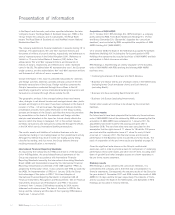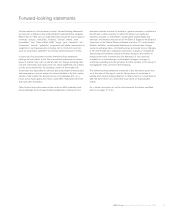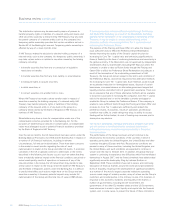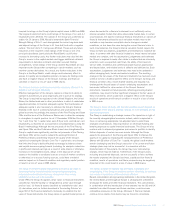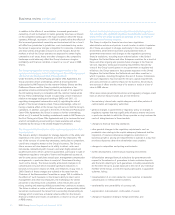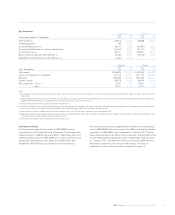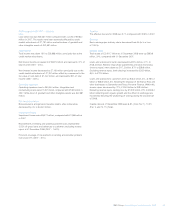RBS 2008 Annual Report Download - page 30
Download and view the complete annual report
Please find page 30 of the 2008 RBS annual report below. You can navigate through the pages in the report by either clicking on the pages listed below, or by using the keyword search tool below to find specific information within the annual report.
29RBS Group Annual Report and Accounts 2008
Despite such measures, the volatility and disruption of the capital and
credit markets have continued at unprecedented levels, and global
recessionary conditions are expected to continue. These conditions
have produced and will continue to produce downward pressure on
stock prices and on availability and cost of credit for financial
institutions, including the Group, and will continue to impact on the
credit quality of the Group’s customers and counterparties. Such
conditions, alone or in combination with regulatory changes or actions
of other market participants, may cause the Group to experience further
reductions in business activity, increased funding costs and funding
pressures, lower share prices, decreased asset values, additional write
downs and impairment charges and lower profitability or losses.
In addition, the Group will continue to be exposed to the risk of loss if
major corporate borrowers or counterparty financial institutions fail or are
otherwise unable to meet their obligations. The Group’s performance may
also be affected by future recovery rates on assets and the historical
assumptions underlying asset recovery rates, which may no longer be
accurate given the unprecedented market disruption and general
economic instability. The precise nature of all the risks and uncertainties
the Group faces as a result of current economic conditions cannot be
predicted and many of these risks are outside the Group’s control.
Lack of liquidity is a risk to the Group’s business and its ability
to access sources of liquidity has been, and will continue to
be, constrained.
Liquidity risk is the risk that a bank will be unable to meet its obligations,
including funding commitments, as they fall due. This risk is inherent in
banking operations and can be heightened by a number of enterprise
specific factors, including an over-reliance on a particular source of
funding (including, for example, short term and overnight funding),
changes in credit ratings or market-wide phenomena such as market
dislocation and major disasters. Credit markets worldwide have
experienced and continue to experience a severe reduction in liquidity
and term-funding in the aftermath of events in the US sub-prime
residential mortgage market and the current severe market dislocation.
Perception of counterparty risk between banks has also increased
significantly following the bankruptcy filing by Lehman Brothers. This
increase in perceived counterparty risk has led to further reductions in
inter-bank lending, and hence, in common with many other banks, the
Group’s access to traditional sources of liquidity has been, and may
continue to be, restricted.
The Group’s liquidity management focuses on maintaining a diverse and
appropriate funding strategy for its operations, controlling the mismatch
of maturities and carefully monitoring its undrawn commitments and
contingent liabilities. However, the Group’s ability to access sources of
liquidity (for example, through the issue or sale of financial and other
instruments or through the use of term loans) during the recent period
of liquidity stress has been constrained to the point where it, like other
banks, has had to rely on shorter term and overnight funding with a
consequent reduction in overall liquidity, and to increase its recourse to
liquidity schemes provided by central banks.
In addition, there is also a risk that corporate and institutional
counterparties with credit exposures may look to reduce all credit
exposures to banks, given current risk aversion trends. It is possible that
credit market dislocation becomes so severe that overnight funding from
non-government sources ceases to be available.
Furthermore, like many banks, the Group relies on customer deposits to
meet a considerable portion of its funding requirements and such
deposits are subject to fluctuation due to certain factors outside the
Group’s control, such as a loss of confidence, competitive pressures or
the encouraged or mandated repatriation of deposits by foreign
wholesale or central bank depositors which could result in a significant
outflow of deposits within a short period of time. Any material decrease
in the Group’s deposits could, particularly if accompanied by one of the
other factors described above, have a negative impact on the Group’s
liquidity unless corresponding actions were taken to improve the
liquidity profile of other deposits or to reduce assets.
The governments of some of the countries in which the Group operates
have taken steps to guarantee the liabilities of the banks and branches
operating in their respective jurisdiction. Whilst in some instances the
operations of the Group are covered by government guarantees
alongside other local banks, in other countries this may not necessarily
always be the case. This may place subsidiaries operating in those
countries, such as Ulster Bank Ireland Ltd, which did not participate in
such government guarantee schemes, at a competitive disadvantage to
the other local banks and therefore may require the Group to provide
additional funding and liquidity support to these operations.
There can be no assurance that these measures, alongside other available
measures, will succeed in improving the funding and liquidity in the
markets in which the Group operates, or that these measures, combined
with any increased cost of any funding currently available in the market,
will not lead to a further increase in the Group’s overall cost of funding,
which could have an adverse impact on the Group’s financial condition
and results of operations or result in a loss of value in RBS shares.
Governmental support schemes are subject to cancellation or change,
which may have a negative impact on the availability of funding in the
markets in which the Group operates.
Governmental support schemes are subject to cancellation or change,
based on changing economic and political conditions in the jurisdiction
of the relevant scheme. Furthermore, certain schemes which have been
recently announced have in fact not been fully implemented, or their
terms have not yet been finalised. To the extent government support
schemes are cancelled or changed in a manner which diminishes their
effectiveness, or to the extent such schemes fail to generate additional
liquidity or other support in the relevant markets in which such schemes
operate, the Group, in common with other banks, may continue to face
limited access to, have insufficient access to, or incur higher costs
associated with, funding alternatives, which could have a material
adverse impact on the Group’s business, financial condition, results of
operations, prospects and result in a loss of value in RBS shares.
The financial performance of the Group has been and will be affected
by borrower credit quality.
Risks arising from changes in credit quality and the recoverability of
loans and amounts due from counterparties are inherent in a wide
range of the Group’s businesses. The outlook for the global economy
over the near to medium term has continued to deteriorate, particularly
in the UK, the United States and other European economies. For
example, there is an expectation of further reductions in residential and
commercial property prices, higher unemployment rates and reduced
profitability of corporate borrowers. As a result, the Group has seen and
expects to continue to see adverse changes in the credit quality of its







